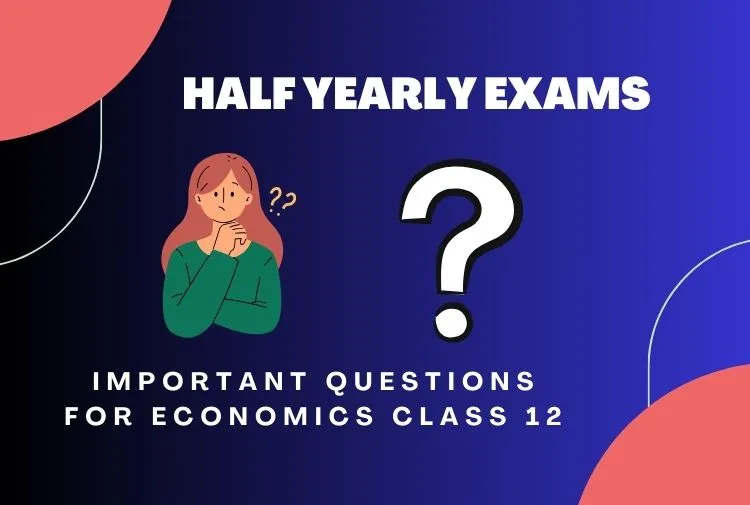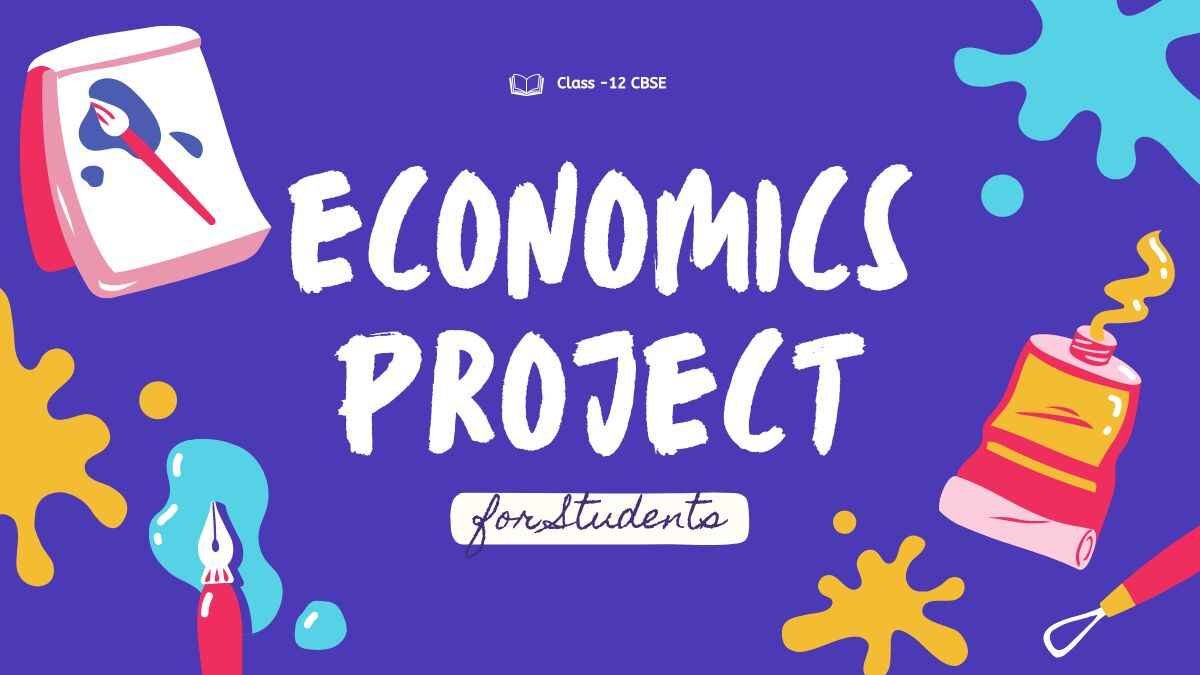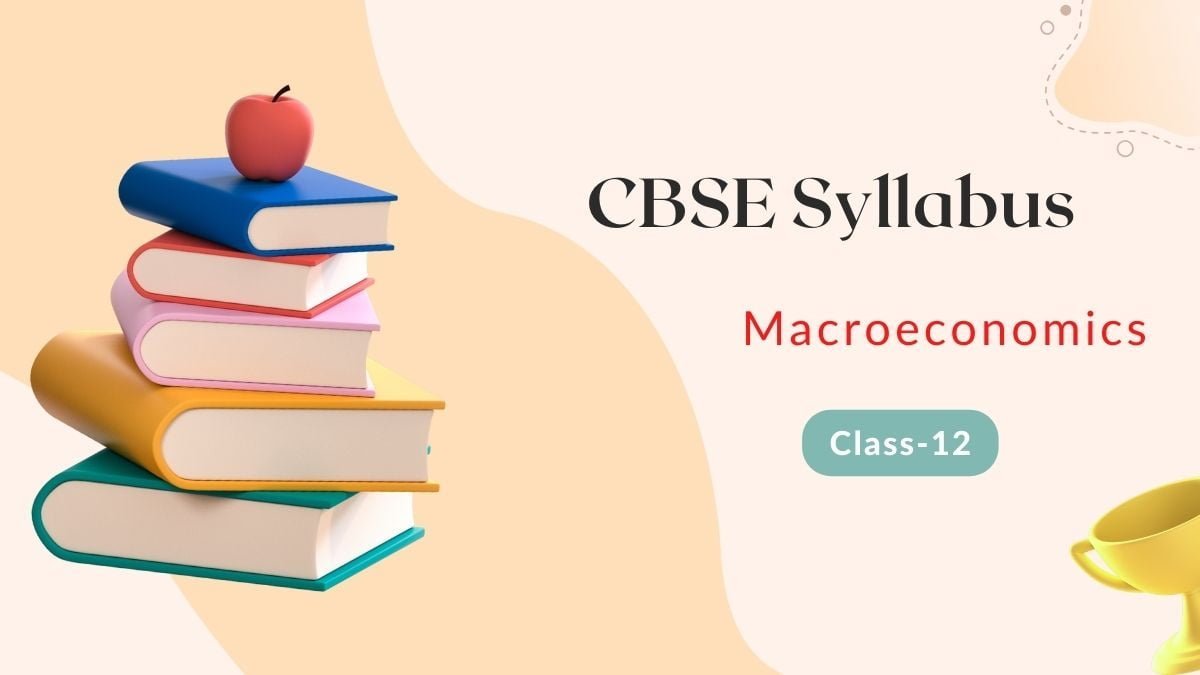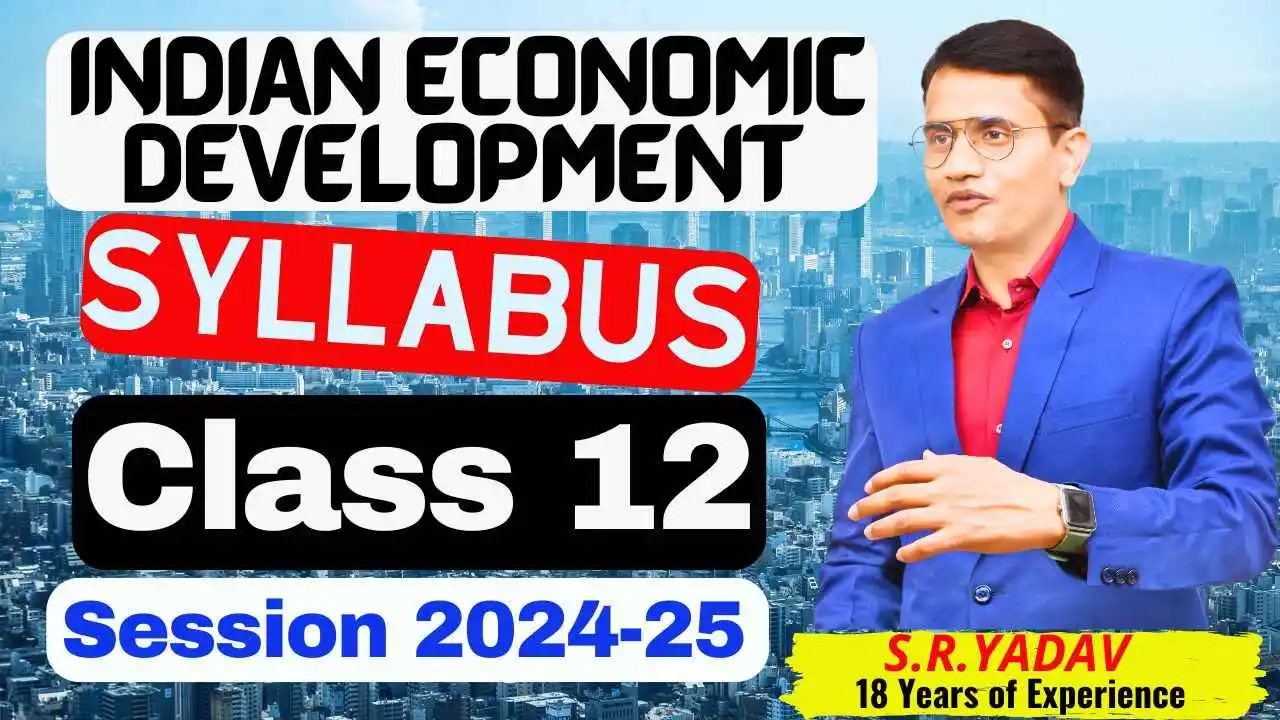How Does Economics Class 12 Important Questions 2024 Help to Prepare for Half-Yearly Exams?
Understanding Target study –
This question bank will help you in your target study for the exam because all these question banks are made up of the same questions that are asked to you frequently in the exam. So, you can find out your target study from this and by studying according to that, you can score well in the exam.
Familiarise with Exam Patterns-
This question bank has been prepared to keep in mind the CBSE pattern, which will help you prepare for your exam and it will also help you understand the CBSE pattern
Identify Important Topics-
With the help of this question bank, you can easily identify the important topics for the half-yearly exam and prepare for them and you will be able to score very well in the exam
Practice for Final Exam-
This question bank will help you in your final board exam and your school’s pre-board exam because while preparing this question bank we have kept the CBSE pattern in mind. So this will help you a lot in your exam.
Macroeconomics Class 12 Important Questions for Half Yearly Exams.
Q.1 If net domestic capital formation is ₹110 crore, gross domestic fixed capital formation is ₹100 crore and change in stock is ₹20 crore, find out the value of depreciation.
(a) ₹30 crore (b) ₹10 crore (c) ₹40 crore (d) ₹20 crore
Q.2 Demand deposits include (choose the correct alternative)
(a) Saving account deposits and fixed deposits. (b) Saving account deposits and current account deposits.
(c) Current account deposits and fixed deposits. (d) All types of deposits.
Q.3 Suppose in a hypothetical economy, the income rises from ₹5000 crore to ₹6000. As a result, the consumption expenditure rises from ₹4000 to 4600 crore. Marginal Propensity to consume in such a case would be___________. (Choose the correct alternative)
(a) 0.8 (b) 0.4 (c) 0.2 (d) 0.6
Q.4 State whether the following statements are True or False:
National income includes the income of only the normal residents of a country
Q.5 Are the following statements true or false? Give reasons.
Loans offered by the central government to the state government are to be treated as capital
Q.6 State whether the following statement is true or false with a reason:
National income is the sum total of factor incomes earned by normal residents and non-residents of a country during the period of an accounting year.
Q.7 Fill in the Blanks
In the context of Macroeconomics equilibrium, AD always refers to______________.(ex-ant e AD/ex-post AD)
Q.8 Fill in the blanks:
Only _______demand deposits are a part of the money supply
Q.9 Fill up the blank with the correct alternatives.
__________________is the basic assumption of the Keynesian macroeconomic model (Excess demand/Excess capacity)
Q.10 Read the following statements -Assertion (A) and Reason(R):
Assertion (A): Borrowing by the government from the Reserve Bank of India are capital receipts.
Reason(R): Borrowing reduces the financial assets of the government.
From the given alternative choose the correct one:
Alternatives:
- Both Assertion (A) and Reason (R) are true and Reason (R) is the correct explanation of Assertion (A).
- Both Assertion (A) and Reason (R) are true and Reason (R) is not the correct explanation of Assertion (A).
- Assertion (A) is true but Reason (R) is false.
- Assertion (A) is false but Reason (R) is true
Q.11 Read the following statements carefully – Assertion (A) and Reason (R). Choose the correct alternatives:
Assertion (A): Real GDP is always equal to Nominal GDP.
Reason (R): Real GDP is a better measure to make periodic comparisons in the physical output of goods and services over different years.
Alternatives:
- Both Assertion (A) and Reason (R) are true and Reason (R) is the correct explanation of Assertion (A).
- Both Assertion (A) and Reason (R) are true and Reason (R) is not the correct explanation of Assertion (A).
- Assertion (A) is true but Reason (R) is false.
- Assertion (A) is false but Reason (R) is true.
Q.12 Read the following statements carefully – Assertion (A) and Reason (R). Choose the correct alternatives:
Assertion (A): APC shows consumption per unit of total income, whereas MPC shows consumption per unit of additional income.
Reason (R): The slope of C – function is indicated by APC.
Alternatives:
- Both Assertion (A) and Reason (R) are true and Reason (R) is the correct explanation of Assertion (A).
- Both Assertion (A) and Reason (R) are true and Reason (R) is not the correct explanation of Assertion (A).
- Assertion (A) is true but Reason (R) is false.
- Assertion (A) is false but Reason (R) is true.
Q.13 What are the implications of a revenue deficit? State two measures to reduce this deficit.
Q.14 When is an economy in equilibrium? Explain with the help of saving and investment functions. Also, explain the changes that take place in an economy when the economy is not in equilibrium. Use diagram.
Q.15 How will you treat the following while estimating the GDP and GNP of India? Give reasons.
(i) Rent earned by an Indian resident from his building in Japan.
(ii) Profits earned by a branch of a British Bank in India.
(iii) Salaries paid to Germans working in the Indian embassy in Germany.
(iv) Salary received by an Indian engineer working in England.
(v) Salary paid to an American technician working in an Indian Company in Delhi.
(vi) Interest earned by an Indian by making bank deposits in Japan.
Q.16 Classify the following into intermediate consumption and final consumption. Also, give reasons.
(i) House rent paid by consumer households.
(ii) Expenditure on research and development by a company.
(iii) Expenditure on maintenance of machinery by a firm.
(iv) Purchase of uniforms for nurses by a hospital.
Q.17 “Higher Gross Domestic Product (GDP) means greater per capita availability of goods in the economy.” Do you agree with the given statement? Give a valid reason in support of your answer.
Q.18 “Marginal propensity to consume falls with successive increase in the level of income” Is this always true?
Q.19 Only one Product X is produced in the country. Its output during the years 2012 and 2013 was 100 units and 110 units respectively. The market price of the product during the year was Rs 50 and Rs Measure the level of ex-ante aggregate demand when autonomous investment and consumption expenditure is ₹50 crore MPS is 0.2 and the level of income(Y) is ₹ 4000 crore. State whether the economy is in equilibrium or not. (give regions)
Q.20 Calculate Domestic Income:
| S.no | Items | ₹ in Crore |
| 1 | Sales by firm X to household | 200 |
| 2 | Sales by firm X to firm Y | 150 |
| 3 | Sales by firm Y to firm X | 50 |
| 4 | Sales by firm Y | 400 |
| 5 | Exports of firm X | 30 |
| 6 | Imports of firm Y | 40 |
| 7 | Import of X | 25 |
| 8 | Net indirect taxes | 30 |
| 9 | Subsidies | 10 |
| 10 | Consumption of fixed capital | 25 |
| 11 | Closing stock of firm X | 35 |
| 12 | Transfer payment from the government | (-)10 |
| 13 | Opening stock of firm Y | 20 |
| 14 | Export of firm Y | 100 |
| 15 | Transfer payment from government | 250 |
Economics Class 12 Important Related Links
- National Income Class 12 Notes
- Money and Banking Notes class 12
- Syllabus of Macroeconomics Class 12
- Online Coaching for Macroeconomics Class 12
- How to Make Economics Project Class 12
Indian Economic Development Class 12 Important Questions for Half-Yearly Exams
Q.21 Which of the following is an indicator of economic development in an economy?
(a) Increase in national income. (b) Increase in per capita income.
(c) Increase in population. (d) all of the above.
Q.22 Which was the last Five-Year Plan in India?
(a) Eleventh plan. (b) Twelfth plan. (c) Thirteenth plan. (d) Fourteenth plan.
Q.23 When was NITI Aayog established?
(a) 1991. (b) 2014. (c) 2016. (d) 2015
Q.24 Identify, which of the following statement is incorrect about the financial sector reform introduced in 1991. (Choose the correct option)
A. Enabled the establishment of private sector banks, Indian as well as foreign
B. Foreign investment limit in banks was raised to around 74%
C. Foreign Institutional Investors were allowed to invest in Indian financial markets
D. Change in the role of the Reserve Bank of India from facilitator to regulator
Q.25 Match the situations given in Column I with their respective implications given in Column II: (Choose the correct alternative)
| Column I | Column II | ||
| A | Source of human capital | (i) | Broader concept |
| B | Source of physical capital | (ii) | Narrow concept |
| C | Human Capital | (iii) | Education, training and health |
| D | Human Development | (iv) | Machinery, Tools and equipment |
(a) A-iv; B-iii; C-ii; D-i (b) A-iii; B-iv; C-ii; D-i
(c) A-iii; B-iv; C-i; D-ii (d) A-iv; B-iii; C-i; D-ii
Q.26 Match the situations given in Column I with their respective implications given in Column II: (Choose the correct alternative)
| Column I | Column II | ||
| A | Beginning of planning in India | i. | 2015 |
| B | Planning Commission | ii. | Twelfth |
| C | NITI Aayog | iii. | 1950 |
| D | Last Five-Year Plan | iv. | 1951 |
Alternatives:
a) A-ii; B-iii; C-iv; D-i b) A-iv; B-iii; C-i; D-ii c) A-i; B-ii; C-iii; D-iv d) A-iv; B-i, C-iii; D-ii
Q.27 Read the following statement carefully and choose the correct alternative given below.
Statement 1: The land ceiling was another policy to promote equity in the agriculture sector.
Statement 2: The purpose of the land ceiling was to reduce the concentration of land ownership in a few hands
Alternatives:
- (a) Both the statements are true.
- (b) Both the statements are false.
- (c) Statement 1 is true and Statement 2 is false
- (d) Statement 2 is true and Statement 1 is false
Q.28 Read the following statement and choose the correct alternative given below:
Statement-1: Globalisation attempts to establish links in such a way that the happening in India does not get influenced by event happening miles away
Statement 2: Globalisation is the outcome of the set of various policies that are aimed at transforming the world towards greater interdependence and integration
Alternatives:
- (a) Both the statements are true.
- (b) Both the statements are false.
- (c) Statement 1 is true and Statement 2 is false
- (d) Statement 2 is true and Statement 1 is false
Q.29 Read the following statements carefully and choose the correct alternative from the following:
Statement 1 –Conditions imposed by the World Bank and the International Monetary Fund were the main reason behind the introduction of economic reforms in India.
Statement 2–The agriculture sector has shown positive growth due to economic reforms. Alternatives:
- (a) Both the statements are true.
- (b) Both the statements are false.
- (c) Statement 1 is true and Statement 2 is false
- (d) Statement 2 is true and Statement 1 is false
Q.30 Explain ‘growth with equity’ as a planning objective.
Q. 31 Why, despite the implementation of the green revolution, 65 per cent of our population continued to be engaged in the agriculture sector till 1990?
Q.32 What was the focus of the economic policies pursued by the colonial government in India? What were the impacts of these policies?
Q.33 Those public sector undertakings which are making profits should be privatised. Do you agree with this view? Why?
Q.34 Establish the need for acquiring information relating to health and education expenditure for the effective utilization of human resources.
Q.35 Argue in favour of the need for different forms of government intervention in education and health sectors.
Q.36 ‘‘Human capital formation gives birth to innovation, invention and technological improvements.” Do you agree with the given statement? Support your answer with valid arguments.
Q.37 Explain the need and type of land reforms implemented in the agriculture sector
Q.38 Discuss economic reforms in India in the light of social justice and welfare.
Q.39 What were the main causes of India’s agricultural stagnation during the colonial period?
Q.40 Do you think outsourcing is good for India? Why are developed countries opposing it?
Read the following text carefully:
Economic reforms were compelled due to international pressure of the situation post-balance of payment crisis of 1991 and a large number of issues such as higher inflation rates, poverty, health care and faster growth of GDP were dealt with as the result of economic reforms. Inefficiency in the public sector was reduced and motivated the private sector. As a result of this policy, NRI gained confidence and started remittances in the country IT/ ITES companies boomed resulting in the creation of a large employment population in the service sector. The contribution of the service sector to GDP increases rapidly.
Reforms were successful in taking out the economy from the payment crisis and giving a positive direction for overall economic growth. In the past few years 4th generation reforms, have been taking place like the creation of a monetary policy committee, the implementation of insolvency and Bankruptcy the implementation of goods and service tax have addressed a number of pressing concerns. The macroeconomic stability of India in this context is a testament to this however many issues still require appropriate resolutions
Based on the given text and common understanding, answer the following questions:
(i) What was the policy for Navratnas
(ii) Discuss economic reforms in India in the light of social justice and welfare.
Conclusion-
You must read this entire question bank and give your feedback, tell us how much you benefited from it and give your suggestions so that we can prepare more question banks for you in future so that you get maximum benefit in the exam and if you like this question bank then please share it with as many students as possible so that everyone can get maximum benefit.










Good evening sir, your questions were very helpful for my half yearly exam. Thank you soo much for this. My pre boards exam are also approaching, in our school from 25 nov. Sir, it’s a humble request can you please upload questions for pre boards too.
Sir, can you please upload questions for pre board too. Half yearly questions were very helpful for me. I’m following you since my 11th class, now I’m in 12th just because of your guidence
sure
Sir, pre boards questions too, pleasee
sure